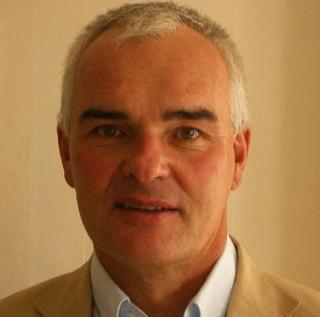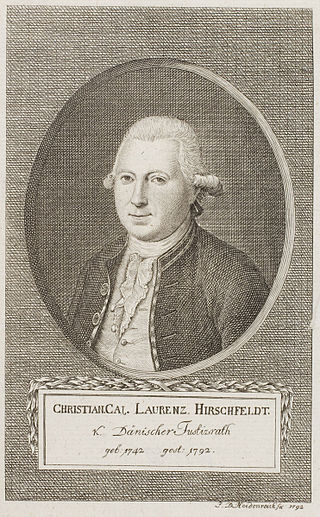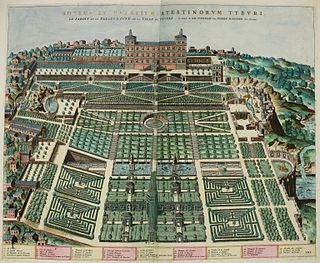
The Englischer Garten is a large public park in the centre of Munich, Bavaria, stretching from the city centre to the northeastern city limits. It was created in 1789 by Sir Benjamin Thompson (1753–1814), later Count Rumford, for Prince Charles Theodore, Elector of Bavaria. Thompson's successors, Reinhard von Werneck (1757–1842) and Friedrich Ludwig von Sckell (1750–1823), advisers on the project from its beginning, both extended and improved the park.

The English landscape garden, also called English landscape park or simply the English garden, is a style of "landscape" garden which emerged in England in the early 18th century, and spread across Europe, replacing the more formal, symmetrical French formal garden which had emerged in the 17th century as the principal gardening style of Europe. The English garden presented an idealized view of nature. Created and pioneered by William Kent and others, the "informal" garden style originated as a revolt against the architectural garden and drew inspiration from paintings of landscapes by Salvator Rosa, Claude Lorrain, and Nicolas Poussin.

Friedrich Ludwig von Sckell was a German landscape gardener from Weilburg an der Lahn. He is regarded as the founder of the English gardens in Germany, which he introduced to the German experts with his writings on garden design. His manner of grouping and choice of plants is still used to an extent in German landscaping today.

Sanssouci is a historical building in Potsdam, near Berlin. Built by Prussian King Frederick the Great as his summer palace, it is often counted among the German rivals of Versailles. While Sanssouci is in the more intimate Rococo style and is far smaller than its French Baroque counterpart, it, too, is notable for the numerous temples and follies in the surrounding park. The palace was designed and built by Georg Wenzeslaus von Knobelsdorff between 1745 and 1747 to meet Frederick's need for a private residence where he could escape the pomp and ceremony of the royal court. The palace's name is a French phrase meaning "without worries" or "carefree", emphasising that the palace was meant as a place of relaxation rather than a seat of power.

Sinn is a municipality in Middle Hesse, Germany, in the Lahn-Dill-Kreis.

Schwetzingen Palace is a schloss in the German state of Baden-Württemberg. Schwetzingen was the summer residence of the Electors Palatine Charles III Philip and Charles IV Theodore. It is situated in Schwetzingen, roughly equidistant from the electors' seats at Heidelberg and Mannheim, and is most notable for its spacious and ornate gardens. Other than these exceptionally well preserved gardens and the palace proper, the compound also features the Schlosstheater Schwetzingen, the principal venue for the annual Schwetzingen Festival.

Bergpark Wilhelmshöhe is a landscape park in Kassel, Germany. The area of the park is 2.4 square kilometres, making it the largest European hillside park, and second largest park on a hill slope in the world. Construction of the Bergpark, or "mountain park", began in 1689 at the behest of the Landgraves of Hesse-Kassel and took about 150 years. The park is open to the public today. Since 2013, it has been a UNESCO World Heritage Site because of its monumental Baroque architecture and its unique fountains and water features.

The Botanical Garden of TU Darmstadt is a botanical garden maintained by the Technische Universität Darmstadt.

The G59 – 1st Swiss Horticulture Exhibition was the first of two Swiss horticulture exhibitions up until now. It took place from April 25 to October 11, 1959, in Zurich and covered an area of about 37 acres on the right and left banks of lower Lake Zurich. The two separate halves of the exposition were connected by commuter ferries and a specially created cable car.

Pillnitz Palace is a restored Baroque schloss at the eastern end of the city of Dresden in the German state of Saxony. It is located on the right bank of the River Elbe in the former village of Pillnitz. It was the summer residence of many electors and kings of Saxony; it is also known for the Declaration of Pillnitz in 1791.

In English gardening history, the pleasure ground or pleasure garden was the parts of a large garden designed for the use of the owners, as opposed to the kitchen garden and the wider park. It normally included flower gardens, typically directly outside the house, and areas of lawn, used for playing games, and perhaps "groves" or a wilderness for walking around. Smaller gardens were often or usually entirely arranged as pleasure grounds, as are modern public parks.

Villa Haas is a historical villa in the small city of Sinn, Hesse located at the western edge of the Hörre in Germany (Lahn-Dill-Kreis). The villa, the park, and the surrounding streets "Hansastrasse / Rudolfstrasse" are cultural monuments due to their historical and artistic significance.

Klaus F. Müller is a German dentist and European pioneer of modern dental implantology. He grew up in Sinn in Hesse, Germany, where he was born on July 20, 1949.
Wilhelm Schacht was a German botanist, gardener, photographer and author. He became known for being senior staff member of Botanischer Garten München-Nymphenburg, whose open air department he took care of for 21 years.

The Martiusstraße in Munich Schwabing leads from Leopoldstraße to Kißkaltplatz. It was named after naturalist Carl Friedrich Philipp von Martius. He was director of the Alter Botanischer Garten in Munich and member of the Bavarian Academy of Sciences and Humanities.

Gerd-Helge Vogel is a German art historian.

Christian Cay Lorenz Hirschfeld was a German Enlightenment gardening theorist, academic in philosophy and art history in the service of Denmark and a writer, notable for several books. He advocated for sensitive Romantic gardens in the English landscape style.
Emil Schultz-Riga was a Baltic Germans-Russian landscape painter of the Düsseldorf school of painting. He also worked with portraits and floral still lifes.

A Renaissance garden is a garden or park created in the era and style of the Renaissance. Because the first such gardens originated in Italy, they are sometimes called Italian gardens. However, gardens made later in Germany, France, or England might have had some differences compared to the original Italian gardens.


















